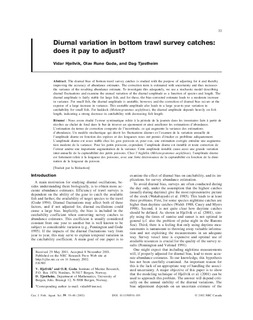| dc.description.abstract | The diurnal bias of bottom trawl survey catches is studied with the purpose of adjusting for it and thereby
improving the accuracy of abundance estimates. The correction term is estimated with uncertainty and thus increases
the variance of the resulting abundance estimate. To investigate this adequately, we use a stochastic model describing
diurnal fluctuations and examine the annual variation of the diurnal amplitude as a function of species and length. The
diurnal amplitude is fairly stable for large fish, and for these, the bias-corrected estimate leads to a moderate increase
in variance. For small fish, the diurnal amplitude is unstable, however, and the correction of diurnal bias occurs at the
expense of a large increase in variance. This unstable amplitude also leads to a large year-to-year variation in
catchability for small fish. For haddock (Melanogrammus aeglefinus), the diurnal amplitude depends heavily on fish
length, indicating a strong decrease in catchability with decreasing fish length. | en |
